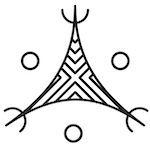poemas de sal y tierra (poems of salt and soil)
Featuring: NATHALIE ALFONSO, STEPHEN ARBOITE, JONATHAN CARELA, RAYMEL CASAMAYOR, NICOLE COMBEAU, ADLER GUERRIER, AMANDA LINARES, ELISA BERGEL MELO, DEVIN OSORIO, CHARLIE QUEZADA, VICTORIA RAVELO
April 12 – May 31 , 2025
📍 homework - 7338 NW Miami CT, Miami FL 33150


































“Cultural identity… is a matter of ‘becoming’ as well as of ‘being.’ It belongs to the future as much as to the past.” — Stuart Hall
‘poemas de sal y tierra (poems of salt and soil)’ is a collective living archive, an ever evolving space where sentiment, symbolism, and memorabilia come together to be held, celebrated, reimagined, and shared. The gallery space functions like a diary written in prose, where the artworks serve as entries–preserving feelings and memories beyond physical artifacts. Artists from the Caribbean and Latin American weave new layers of meaning into inherited stories, places and objects, transforming memory into an active conversation that continues to unfold.
poemas de sal y tierra (poems of salt and soil), explores the idea that we both come from and become the places we move through. Salt and soil, fundamental to land and sea, symbolize ancestral geographies. Through the use of various mediums–painting, drawing, sound, film, photography and sculpture– artists translate ephemeral histories, embodied knowledge and shifting landscapes into tangible artworks, much like poetry makes visible the invisible threads of our existence.
Archiving is ingrained in the works in the exhibition through process, collection, research and medium. For Raymel Casmayor, sound is a sensory archive from which he creates an immersive audio installation from field recordings of various neighborhoods in Havana–collapsing distance and time. Objects and memorabilia accompany the soundtracks, serving as markers of collected memories. Victoria Ravelo also collapses distance through the use of found materials and photography. Her works build relationships between places that have once existed as a home, by creating “portals” connecting each in an attempt to bridge the separation between geographies and map the memories that exist in those distances.
Memory exists as an important material in both the process of creation and the reading of each of the works. Charlie Quezada’s research-driven practice translates architectural memory and history into visual entries that preserve and reinterpret physical form and conceptual borders in collective identity through minimalism and the deliberate use of color, texture and materials. Stephen Arboite’s practice meditates on the intricacies of memory, cultural identity and heritage through a layered process and intentional use of materials like coffee, pigments and fire. The machete, while widely known as a symbol of resistance, serves as a motif of protection, memory and familial legacy. The work of Devin Osorio also explores a merging of both personal and cultural memories. Their embroidered paintings act as personal shrines, holding stories of life shaped by the origins of the diaspora and the ongoing personal search for belonging and self.
Elisa Bergel Melo links the history of pearl exploration off the Venezuelan coast to her personal lineage. A chainmail mesh resembling a net, along with photographs from her family’s archive symbolically connect her Venezuelan homeland to her current home of Santo Domingo. This act becomes a gesture of care, allowing her to protect and honor her family’s displacement, assuming the role of custodian of their collective memory. Also investigating notions of homeland, films by Jonathan Carela explore and question the everyday language, tempo and social structures embedded in the landscape of the Dominican Republic.
For Amanda Linares the use of concrete references the permanence of our physical environments and the structural material of a home. She adds nostalgic graphite drawings to the surface of the concrete, embedding the ephemerality of memory into material. The work of Nathalie Alfonso centers around ephemerality and site-specificity. Her gestural drawings exist as one within space and explore repetition, invisibility and resistance. They become a record and a reflection of the invisible ecosystems at work in landscapes we move through.
Plants and gardens appear as places of refuge and of comfort. Nicole Combeau creates poetic multiple exposure photographs to seamlessly weave together narratives that explore lineage, memory, loss and renewal. Printed on silk, the image becomes a delicate object within each space it inhabits. For Adler Guerrier the garden is a space for dreaming and a space of shelter. Within the landscape we can be, and we can also become. The photographs propose a layering of possibility, while grounding us in place and the present moment.
Through their work, the artists transform fragments of themselves into an active, breathing record of resilience and reverence for their roots, lived experiences and their own sense of belonging. This exhibition is ultimately a reflection of how we collect, connect and preserve the intangible, and how we return to it for comfort, clarity, and renewal. Here, collective memory isn’t fixed; it shifts, grows, and evolves through each work.
-curated by FORGOTTEN LANDS and homework
